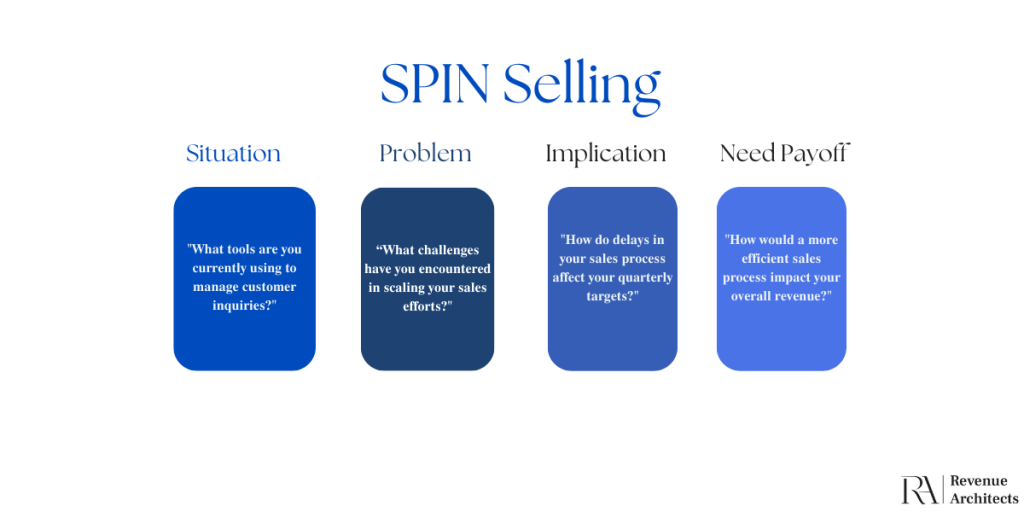Selling isn’t just about pushing a product into the market; it’s about understanding the customer’s needs and presenting your product as the solution to their challenges. One methodology that has proven its mettle over decades is SPIN Selling. Created by Neil Rackham after observing over 35,000 sales calls, SPIN Selling redefined how salespeople approach the conversation with clients. Instead of focusing on the hard sell, SPIN Selling encourages professionals to dig deeper into the prospect’s challenges and frame the solution to address their specific needs.
If you’re in sales and haven’t yet explored SPIN Selling, this article will guide you through its key principles and show you how it can revolutionize your approach to closing deals.
What is SPIN Selling?
SPIN Selling is a sales methodology based on four questions: Situation, Problem, Implication, and Need-Payoff. These questions help salespeople uncover a prospect’s pain points, understand the impact of those issues, and position their product or service as the ideal solution.
But SPIN isn’t just about the questions themselves—it’s about how they are used in a conversation. Using the SPIN methodology, a skilled salesperson will steer the prospect towards recognizing their needs, making the close feel natural and unforced.

The SPIN Framework: Breaking It Down
The core of SPIN Selling revolves around four key types of questions, each designed to gather specific information and guide the sales process. Let’s examine each type.
Situation Questions
Situation questions are the opening salvo of your conversation. They’re designed to gather essential information about the prospect’s current circumstances, setting the foundation for deeper exploration later.
Example questions:
- “What tools are you currently using to manage customer inquiries?”
- “How is your sales team structured?”
While these questions are essential for gathering primary data, they should not dominate the conversation. Asking too many situation questions can feel redundant and might bore the prospect. The goal is to extract the necessary information without making the client feel like they’re taking a tedious survey.
Problem Questions
Once you’ve understood the situation, the next step is to uncover the problems. Problem questions are crucial because they reveal the pain points that your product or service can solve.
Example questions:
- “Are you satisfied with how quickly you can respond to customer inquiries?”
- “What challenges have you encountered in scaling your sales efforts?”
At this stage, it is critical to let the prospect express their frustrations freely. The more they articulate their issues, the more compelling the solution will appear later.
Implication Questions
Implication questions are where the magic of SPIN Selling happens. These questions force the prospect to consider the consequences of their problems, helping them see how unresolved issues can negatively impact their business.
Example questions:
- “If your team can’t respond to customer inquiries quickly, what impact could that have on customer satisfaction?”
- “How do delays in your sales process affect your quarterly targets?”
Implication questions build urgency by highlighting the cost of inaction. The prospect begins to see their problem as something they can’t afford to ignore, positioning your solution as a necessary investment.
Need-Payoff Questions
Finally, need-payoff questions guide the prospect toward envisioning the benefits of solving their problem. Rather than telling them how great your product is, these questions allow the prospect to articulate the value themselves.
Example questions:
- “If you could improve response times, how would that affect customer retention?”
- “How would a more efficient sales process impact your overall revenue?”
This phase is essential for turning the conversation from problem-focused to solution-oriented. Once the prospect starts to visualize the positive outcomes, they become more emotionally invested in resolving their issues and purchasing your solution.
The Importance of Listening in SPIN Selling
SPIN Selling isn’t about bombarding the prospect with questions and waiting for the chance to pitch. It’s about active listening. The questions are simply tools to help you guide the conversation. The real goal is understanding the prospect’s unique situation and offering a tailored solution.
During SPIN conversations, salespeople must listen intently, noting key phrases, emotions, and the prospect’s framing of their challenges. This deeper level of engagement builds rapport and allows for more meaningful responses when it comes time to discuss the solution.

Adapting SPIN to Modern Sales
While SPIN Selling has been around for decades, it remains incredibly relevant today, particularly in complex B2B sales. The world has changed, and so has the way buyers approach purchasing decisions. Today’s buyers are more informed, have access to online information, and are wary of aggressive sales tactics.
SPIN Selling offers a consultative approach in this landscape that aligns with modern buyers’ preferences. It shifts the focus from the product to the buyer’s needs, empowering them to make informed decisions.
Leveraging Technology with SPIN
Salespeople today have many tools, from CRM systems to AI-powered analytics platforms. While these tools can provide valuable insights into the prospect’s situation and problems, it’s still essential to maintain the human element of the sale. SPIN Selling complements technology by adding structure to the conversations that tools alone can’t replicate.
For instance, while AI can help predict a prospect’s pain points based on data, SPIN questions can extract deeper emotional insights that AI alone might miss. Combining SPIN’s question-based approach with technology allows a more nuanced understanding of the buyer’s needs.
SPIN Selling in Action: Real-World Examples
To better understand the power of SPIN Selling, let’s look at a few examples of how this method has been applied in real-world sales scenarios.
Case 1: Software Sales
A salesperson for a SaaS company selling customer service platforms used SPIN Selling to close a deal with a large enterprise. The situation questions revealed that the company used outdated, on-premise customer service software. Through problem questions, the salesperson discovered that customer inquiries were often delayed due to the slow system. The implication questions helped the enterprise realize the delay was costing them customers. Finally, need-payoff questions showed the prospect how switching to the cloud-based platform could improve customer satisfaction and increase retention.
Case 2: Manufacturing Equipment
A sales rep for a manufacturing equipment company used SPIN Selling during a negotiation with a production manager. The situation questions uncovered that the factory was experiencing frequent machinery breakdowns. The problem questions revealed that these breakdowns slowed production and increased costs. Implication questions made the manager acknowledge that delays affected their ability to meet client demands. With need-payoff questions, the sales rep helped the manager see how new equipment could streamline production and reduce downtime.
In both cases, the SPIN methodology helped the sales reps guide the conversation so that the prospects realized the urgency of their problems and the value of the solution.
How to Implement SPIN Selling in Your Sales Process
If you’re ready to start using SPIN Selling in your sales process, here are a few practical steps to get started:
- Prepare Your Questions: Before every sales call, think about the specific situation, problem, implication, and need-payoff questions you’ll ask based on the prospect’s industry and challenges.
- Practice Active Listening: SPIN Selling relies heavily on your ability to listen and respond to what the prospect is saying. Practice listening without interrupting, and let the prospect’s answers guide the flow of your questions.
- Adapt Your Approach: SPIN Selling is not a rigid script. Tailor your questions and responses to the specific prospect you’re speaking with. Every conversation will be different, so be flexible and adaptable.
- Use Technology: Leverage CRM systems, AI, and data analytics tools to get insights into your prospects before the conversation. These tools can provide valuable context for your SPIN questions.
- Follow-Up: After the conversation, follow up with a tailored proposal that directly addresses the problems and needs uncovered during the SPIN conversation.
The Future of SPIN Selling
SPIN Selling remains a cornerstone methodology for sales professionals across industries as sales evolve. While digital tools and platforms will undoubtedly continue to shape the future of sales, the human element—understanding and addressing customer pain points—will always be critical.
SPIN Selling offers a timeless framework for doing just that, helping salespeople build deeper relationships with their prospects and position their products as essential solutions to real-world problems.

Need someone to help you improve your sales process?
SPIN Selling can seriously transform how you close deals, but mastering it takes more than just knowing the theory—it’s about applying it the right way. That’s where we come in. Our sales coaching is all about helping you and your team nail SPIN Selling and other techniques that drive real results.
With our coaches by your side, you’ll learn how to ask the right questions, close more deals, and build stronger client relationships. Plus, we’ll help you fine-tune your sales process to increase your revenue.
Ready to level up your sales game? Get in touch today and find out how we can help you boost performance and grow your business.

